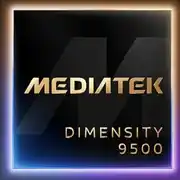MediaTek Dimensity 9500

MediaTek Dimensity 9500 — fast, cool, and clearly aiming for the top
Dimensity 9500 is MediaTek’s flagship on TSMC’s 3-nm N3P node. The “all big cores” concept stays, but the focus shifts to steady single-thread speed, console-style ray-traced graphics, and strong on-device AI.
Key points at a glance
-
CPU (Armv9.3): 1× C1-Ultra + 3× C1-Premium + 4× C1-Pro; larger caches (up to 16 MB L3) for responsiveness without frame-time dips.
-
GPU: Arm Mali-G1 Ultra (MC12) with accelerated hardware ray tracing and frame generation up to 120 FPS in RT scenes.
-
Memory / storage: LPDDR5X up to 10,667 MT/s; UFS 4.1 “4-lane” for faster sequential transfers and quicker AI model loads.
-
Connectivity: 5G Sub-6 (FR1) with up to 5CC CA; Wi-Fi 7 (TBTC, peak 7.3 Gbps); Bluetooth 6.0 (dual engine).
-
Cameras / video: sensors up to 320 MP, video up to 8K60, plus 4K120 with EIS and “cinematic” 4K60.
-
AI: NPU 990 (2nd-gen Gen-AI Engine) + ultra-efficient CIM block; on-device image generation up to 4K and snappy agent-style tasks.
What’s better vs Dimensity 9400
Faster prime core and more cache. L3 grows to 16 MB (9400 had less), and the new “ultra core” boosts single-thread and short, heavy bursts—app launches, photo processing, exports.
Next-step storage. Swaps UFS 4.0/MCQ for UFS 4.1 4-lane: quicker AI model loading and media I/O, fewer “hiccups” in multitasking.
Noticeably stronger graphics. Mali-G1 Ultra MC12 raises peak FPS and pushes ray tracing much harder; frame upscaling/generation up to 120 FPS in RT scenes.
Camera/video headroom. Sensor support climbs to 320 MP; video ceiling moves to 8K60 plus 4K120.
Comparison with competitors
Versus Snapdragon 8 Gen 4
-
Memory / storage. Both use LPDDR5X; 9500’s ace is UFS 4.1 “4-lane”, while 8 Gen 4 more often ships with UFS 4.0. For AI apps and heavy games that means smoother loads and fewer micro-stutters.
-
CPU profile. 9500 goes “1+3+4” with big caches; 8 Gen 4 typically “2+6”. Qualcomm is traditionally strong in short bursts, but 9500 closes the single-thread gap via a higher-clocks prime core and bigger L3, holding frequency longer.
-
GPU / RT. Adreno is famous for peak throughput and drivers; 9500 counters with robust hardware RT and frame generation up to 120 FPS. In non-RT titles engine optimization decides; with RT enabled, 9500 often feels steadier on frame pacing.
Versus Exynos 2500
-
Process and CPU. Both on 3 nm, different philosophies: Exynos runs 10 cores with an emphasis on efficiency and long-haul stability; 9500 doubles down on “all big cores” and responsiveness. 9500 tends to be quicker in short bursts, Exynos is very stable over sustained background loads.
-
AI. Exynos pushes impressive “paper” TOPS; 9500’s NPU 990 + CIM combo shines in real, prolonged offline scenarios (assistants, generation) without cooking the battery.
-
Cameras / video. Top modes are broadly aligned—8K60, advanced HDR/portrait chains; 9500 stands out with flexible 4K120 and wide sensor support up to 320 MP.
Who should pick this chip
-
Power users and creators. Fast single-thread + UFS 4.1 “4-lane” = snappy imports/exports and calmer multitasking.
-
Mobile gamers. Ray-traced titles benefit: higher RT performance, frame generation up to 120 FPS, and cooler hands thanks to N3P and larger caches.
-
Mobile filmmakers. 4K120 with EIS and “cinematic” 4K60 open creative options; headroom up to 8K60.
-
Battery-first users who hate throttling. N3P + larger caches + smarter schedulers reduce power spikes and keep performance steady in hand.
Basic
GPU Specifications
Connectivity
Memory Specifications
Miscellaneous
Benchmarks
Phones with Dimensity 9500




Comparison of Devices with Dimensity 9500
Compared to Other SoC
Related SoC Comparisons
Share in social media
Or Link To Us
<a href="https://cputronic.com/en/soc/mediatek-dimensity-9500" target="_blank">MediaTek Dimensity 9500</a>

